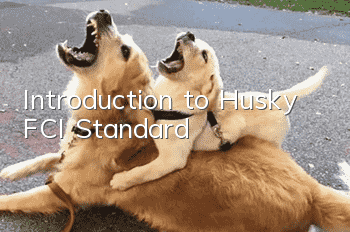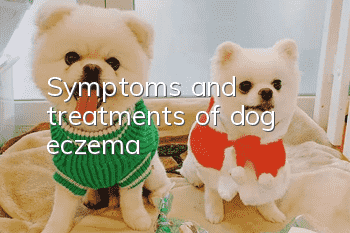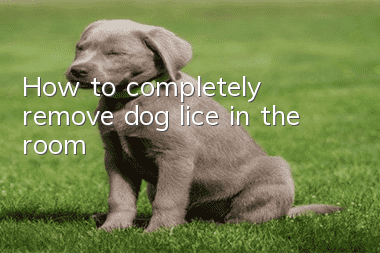Introduction to Husky FCI Standard

Although the Husky looks a bit ferocious, it is a very gentle and sociable dog breed. It does not show the strong territorial possessiveness of a guard dog, nor is it too suspicious of strangers. Attack other dogs. Having said so many benefits, let’s take a look at the FCI standards of Husky with the editor, so that you can have peace of mind when purchasing.
Husky’s FCI number: 270
The FCI group of Husky belongs to: Group 5: Sharp-billed Dog and Primitive Dog Breed Group
Husky height: Male Huskies are 20.9-23.6 inches (53.0-60.0 cm) tall at the shoulders, and female Huskies are 20.1-22.1 inches (51.0-56.0 cm) tall at the shoulders.
The weight range of huskies: male huskies weigh 44.1-59.5 pounds (20.0-27.0 kg), female huskies weigh 35.3-50.7 pounds (16.0-23.0 kg)
Husky’s head
Skull: Medium size, in proportion to the body; slightly rounded at the top, tapering from the widest point toward the eyes. Stop: Well defined. Nose: Gray with black, brown or black; copper with dark auburn; pure white dogs may be flesh-colored. A "snow nose" with pink stripes is also available. Muzzle: Of medium length and width, tapering gently toward the nose, neither pointed nor square at the top. The bridge of the nose is straight from stop to top. Lips: Naturally pigmented and tight. Jaws/Teeth: Closed, scissor bite. Eyes: Almond-shaped, moderately spaced and slightly slanted. The color is brown or blue; one of each (color) or mixed colors are also available. Ears: Medium size, triangular, set high on the head and well set. The ears are thick but well-coated. The back of the ears is slightly arched, firm and erect. The tips of the ears are slightly rounded and point straight upward.
Husky’s torso
Neck: Moderate in length, arched, and carried erect when the dog stands. When trotting, the neck is extended and the head is slightly forward. Chest: Deep, strong, but not too broad, with the deepest point just behind and level with the elbows. Back: Slightly arched, strongly erect, slightly rounded at the tip, pointing straight upward. Waist: Tight, sloping, narrower than ribcage, slightly tucked in. Ribs: Well sprung outward from the spine, but flattened laterally to allow for free movement.
Husky’s limbs
Forequarters: Viewed from the front when standing, the legs are well spaced, parallel, and straight. Good bone but not heavy. The length of the leg from the elbow to the ground is slightly longer than the distance from the elbow to the top of the shoulder blade. The dewclaws on the front feet should be removed. Shoulders: The shoulder blades naturally slope backward. The upper arm is slightly tilted from the shoulder to the elbow, not perpendicular to the ground. The muscles and ligaments are well developed and firmly connect the shoulders to the ribcage. Elbows: Close to the body, neither turned in nor turned out. Pasterns: Strong but flexible. Viewed from the side, the pasterns are slightly slanted. Hindquarters: Viewed from behind when standing, the hind legs are well apart and parallel. Dewclaws must be removed. Thighs: Muscular and strong. Stifle joint: Bend naturally. Hock: Distinctly shaped, close to the ground. Feet: Oval but not long. Claws are medium in size, compact and well haired between toes and pads. The pads are thick and thick, and neither turn in nor turn out when the dog is standing naturally.
Husky’s tail
Tail: Fox-shaped, well-coated, just below the height of the topline. When the dog is concentrating, it is usually raised over the back and bent into a sickle shape. When lifted, the tail does not curl to either side of the body or fold down against the back. Dragging the tail when resting is normal. The tail hairs are of medium length, with the top, sides and lower parts roughly equal in length, and look like a round brush.
Husky gait/movement
The typical gait of the Siberian Husky is smooth and easy. It is light on its feet and will trot at a moderate pace when shown, thereby demonstrating the natural reach of its forequarters and the powerful drive of its hindquarters. When walking, looking from the front to the back, you can see that it is not walking in a single line, but as the speed gradually increases, the legs will gradually step inward, and eventually the foot pads will step on a straight line below the center of the body in the depth direction. Like the pads of the feet, the front and rear legs are raised forward, and the elbows and stifles do not turn in or out. Each hind leg moves in the same line as the front leg on the same side. When the dog walks, its topline is firm and even.
Huskies’ disqualification conditions
Faults: Any deviation from the above points will be considered a fault, and any dog that is obviously abnormal in body or behavior will be disqualified. · Clumsy or heavy skull, too pronounced outline · Inadequate stop · Muzzle Too long or too rough; Too short or too long · Bite other than scissor bite · Slanted eye position; too close position · Neck Too short or too thick; too long, weak back or sloping back; arched; sloping topline, chest too wide, barrel chest; ribs too flat or weak, tail tightly curled; feathery; set too high or too high Low, straight shoulders; loose, weak pasterns in forequarters, too heavy bones; too narrow or too wide in front; elbow valgus, soft or splayed toes on feet; oversized or cumbersome claws; too small and weak claws; toes Turning or turning in; Long, thick, shaggy coat; Texture that is too coarse or fine; Unauthorized trimming; Dog over 23.5 inches (60 cm),Female dogs over 22 inches (56 cm)
- What to do if Teddy's hair is seriously tangled
- How to tell if your dog’s tear ducts are blocked
- How to treat mites on dogs? It’s all caused by incorrect cleaning!
- What should you pay attention to when choosing a dog?
- How should you train a Border Collie when it comes to a new home? Home training for Border Collies!
- What causes liver and ascites in dogs?
- Is a crate necessary for dogs?
- At what age can dogs be dewormed internally and externally? Things to do with deworming dogs!
- Is it okay for dogs to walk upright? Is it dangerous for dogs to walk upright?
- There are so many reasons behind dogs licking their noses. Have owners thought of it?



